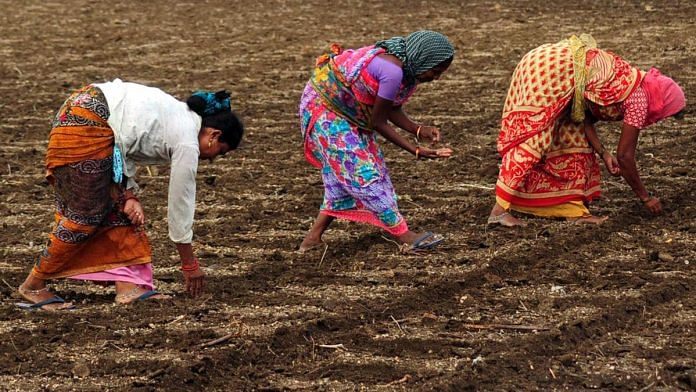Amid growing concerns about the economy, mainstream papers note the Ministry of Home Affairs’ guidelines for the resumption of economic activity from 20 April but with the caveat that the implementation will hinge on how states and Union Territories interpret the guidelines.
Pink papers put RBI in the hot seat, with Mint suggesting the central bank look at corporate bond purchases just as the US Federal Reserve has done.
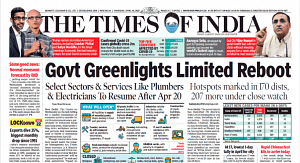 The Times Of India’s lead story ‘Govt Greenlights Limited Reboot’ says the limited resumption of economic activity from 20 April will be “outside Covid-19 containment zones, particularly in industrial zones and rural areas’’ with strict workplace norms and permits.
The Times Of India’s lead story ‘Govt Greenlights Limited Reboot’ says the limited resumption of economic activity from 20 April will be “outside Covid-19 containment zones, particularly in industrial zones and rural areas’’ with strict workplace norms and permits.
Showing that it means real business, the government has now identified more hotspots: ‘Hotspots marked in 170 dists, 207 more under close watch’.
These ‘red zone’ areas included all six metros — Delhi, Mumbai, Kolkata, Chennai, Bengaluru and Hyderabad as well as Bhopal, Agra, Gurugram, Noida and Faridabad. “Besides, 207 districts — where the rate of doubling is currently low but which can be potential hotspots — have been classified as ‘non-hotspots’ or ‘white zones’. Apart from this, there are ‘green zone’ districts with no new confirmed Covid-19 case in the last 28 days”, reports TOI.
If a picture speaks a thousand words, this one may speak a million: A photograph of people camped on the banks of the Yamuna in Delhi with no place else to go during the lockdown.
And in other Covid-19 developments, ‘TJ chief booked for culpable homicide’. TOI reports saying Delhi Police have booked Maulana Saad, chief of Tablighi Jamaat, and six associates “for culpable homicide’’ for organising the meeting of their followers in Delhi’s Nizamuddin area that has led to many Covid-19 infections and deaths across the country.
“With the maulana’s quarantine period now about to get over, the cops will decide whether to arrest him after recording his statement,” adds TOI.
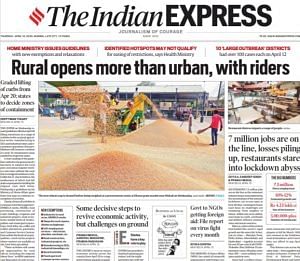 The Indian Express’ lead credits the government’s preparedness for the extended 19-day lockdown and “keenness” to support rural and urban workers worst-affected by it. In ‘Rural opens more than urban, with riders’, it compares the “suddenness” of the 21-day lockdown, “which had left states unprepared in tackling the migrant rush back home”, with Wednesday’s guidelines that gives them “five days to calibrate resumption of activities”.
The Indian Express’ lead credits the government’s preparedness for the extended 19-day lockdown and “keenness” to support rural and urban workers worst-affected by it. In ‘Rural opens more than urban, with riders’, it compares the “suddenness” of the 21-day lockdown, “which had left states unprepared in tackling the migrant rush back home”, with Wednesday’s guidelines that gives them “five days to calibrate resumption of activities”.
Express analyses the government’s move in, ‘Some decisive steps to revive economic activity, but challenges on ground’. It says the lockdown will hinge on how states interpret the MHA’s guidelines and the migrant workers issue. It pats the Centre on the back for “involving truckers and ensuring supporting infrastructure such as eateries along highways and repair shops being allowed to open” – a move that could provide employment and ease “supply chains bottlenecks”.
The lockdown has also put 7.3 million jobs are at stake and about half-a-million restaurants across the country fear they could be forced out of business in the absence of relief measures, notes the paper’s second lead (‘7 million jobs are on the line, losses piling up, restaurants stare into lockdown abyss’).
In a follow-up report (‘TV reporter arrested for Bandra migrant gathering, channel calls it outrageous’) to the Bandra station debacle Tuesday, an ABP Majha journalist and 11 others have been arrested for “rumour mongering”. ABP Majha has slammed the move and called for “due verification of all facts and circumstances”, in the case.
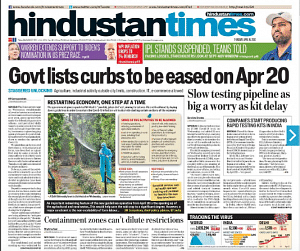 Hindustan Times’ lead story is similar to TOI’s. In ‘Govt lists curbs to be eased on Apr 20’, it notes that the government “green-lighted work under the federal job guarantee scheme, and permitted daily wagers in some areas to return to work.”
Hindustan Times’ lead story is similar to TOI’s. In ‘Govt lists curbs to be eased on Apr 20’, it notes that the government “green-lighted work under the federal job guarantee scheme, and permitted daily wagers in some areas to return to work.”
The other major report concerns testing: ‘Slow testing pipeline as big a worry as kit delay’. “India carried out close to 27,000 Covid-19 tests on Wednesday and added 22 new labs in the last two days… but has suffered from long delays due to several bottlenecks”, the report notes. It adds, “Speed of testing is a critical area where India may be falling behind, with a large backlog of tests awaiting results at the end of every working day.”
It’s the season for predictions and IMD doesn’t let us down: “Normal monsoon forecast brings some cheer to India” reports that the monsoon is “likely to be normal this year at 100% of the long-period average (LPA), the India Meteorological Department (IMD) said on Wednesday…”
And while this may bring relief to farmers, the migrant distress continues: The report, ‘Migrants in some regions begin to walk’’ writes that “Three separate incidents of migrants trying to walk back to their homes in other states were reported from Hyderabad. All of them were sent back… Similar incidents of workers being stopped from taking a walk were reported from other areas as well. Workers in Punjab, Telangana, Haryana and Odisha said they would start walking home shortly as the ration they received was about to be exhausted.”
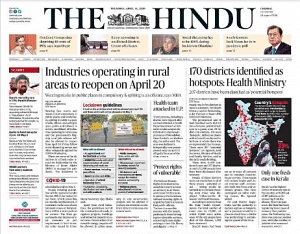 Like all newspapers, the The Hindu leads with the government’s moves to kickstart the economy and its opening paragraph lays out the plans in succinct, accessible language: “Wearing face covers and masks is now compulsory in public places and workplaces, spitting in public is a punishable offence and selling liquor, gutka and tobacco is strictly prohibited. All industries operating in rural areas and the government’s flagship rural jobs scheme will also be allowed to reopen from April 20 if they follow social distancing norms and other safeguards against the COVID-19 infection.”
Like all newspapers, the The Hindu leads with the government’s moves to kickstart the economy and its opening paragraph lays out the plans in succinct, accessible language: “Wearing face covers and masks is now compulsory in public places and workplaces, spitting in public is a punishable offence and selling liquor, gutka and tobacco is strictly prohibited. All industries operating in rural areas and the government’s flagship rural jobs scheme will also be allowed to reopen from April 20 if they follow social distancing norms and other safeguards against the COVID-19 infection.”
Hindu gives equal importance to ‘170 districts identified as hotspots: Health Ministry’. It says, “Nearly one in five districts in India is a hotspot,’’ according to the Health Ministry. The government had classified “every district into a hotspot, potential hotspot or a green zone. Of India’s 736 districts, 170 were ‘hotspots’, defined as places with at least 15 confirmed infections or where there was an exponential rise in cases. There were 207 ‘potential hotspots,’” the paper says quoting Lav Agrawal, Joint Secretary, Ministry of Health and Family Welfare.
And in a telling photograph captioned “chain reaction”, Hindu has a photo of people waiting to receive food in Patna, amid the extended lockdown, with little attention to social distancing.
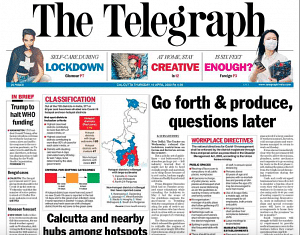 The Telegraph’s front page has a detailed chart explaining the colour scheme of the hotspots and how they signify the level of severity of cases.
The Telegraph’s front page has a detailed chart explaining the colour scheme of the hotspots and how they signify the level of severity of cases.
The lead story of the Kolkata daily is ‘Go forth & produce, questions later’. If The Hindu was succinct, Telegraph is quite the opposite: “The Centre on Wednesday relaxed the lockdown restrictions on farms and factories across the country. But a patchy set of guidelines — not buttressed by a stimulus package yet — left industry worried that it might not be able to herd enough people and materials on to shop floors because of travel curbs, broken supply chains and badly frayed retail networks… the scope of the guidelines suggests the government is wrestling with the compulsion of alleviating the pain of restive migrant workers who have been stuck in cities with no money and no prospect of returning home.”
While in Kolkata-related news: Kolkata and nearby hubs are among hotspots. Telegraph explains, “The Union health ministry on Wednesday listed 170 districts nationwide, including Calcutta, Howrah, East Midnapore and North 24Parganas, as “hotspots” for Covid-19 that can earn the infection-free tag only if they report no new cases for 28 days.
And here is an example of how stretched medical services are, leading to untold misery for potential patients.
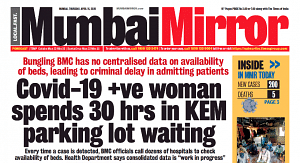 Mumbai Mirror’s lead story recounts how a “A 66-year-old resident of Delisle Road tested positive for Covid-19 on Tuesday morning’’ and waited 30 hours in KEM’s parking lot before she was allotted a bed at St George’s Hospital.
Mumbai Mirror’s lead story recounts how a “A 66-year-old resident of Delisle Road tested positive for Covid-19 on Tuesday morning’’ and waited 30 hours in KEM’s parking lot before she was allotted a bed at St George’s Hospital.
The husband of a pregnant Covid-19 positive woman, whose due date is April 17, struggled for 24 hours to get her admitted to a hospital.
And there was a a Covid-19 positive resident of south Mumbai who was “taken on a four hour tour of four hospitals – at each place he was told there were no beds vacant – before he was admitted at SevenHills.’’ Mumbai Mirror says this is “damning evidence… of an overwhelmed civic and state machinery struggling to come to grips with rapidly multiplying cases of coronavirus infections”.
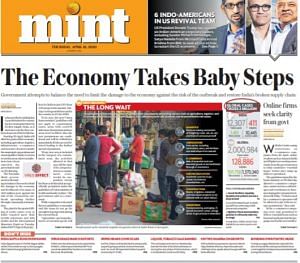 Mint’s lead ‘The Economy Takes Baby Steps’ says that MHA’s guidelines are to put India’s “battered economy back to work and restore its broken supply chain”. However, it adds that there are mixed opinions about the moves: “While companies welcomed the new guidelines, economists said the steps do not go far enough to boost growth during the current fiscal.”
Mint’s lead ‘The Economy Takes Baby Steps’ says that MHA’s guidelines are to put India’s “battered economy back to work and restore its broken supply chain”. However, it adds that there are mixed opinions about the moves: “While companies welcomed the new guidelines, economists said the steps do not go far enough to boost growth during the current fiscal.”
In a grim report (‘Without cure, social distancing may be here to stay till 2022’), the paper reports a new study by Harvard University that suggests social distancing will persist well into 2022, “in the absence of vaccines, to prevent frequent coronavirus outbreaks”. The study also makes a distinction between Covid-19 and SARS: “SARS-CoV-2, the virus that causes covid-19 in humans, is unlikely to behave like its closest cousin, SARS-CoV-1, and won’t be eradicated by intensive public health measures after causing a brief pandemic”.
An analytical report puts RBI in the hot seat. In ‘RBI must take bolder steps to boost growth’, the pink paper says the central should look at “corporate bond purchases and measures to facilitate a credit guarantee scheme along with the government”. It points out that the RBI has been “reluctant to follow in the footsteps of the US Federal Reserve and purchase corporate bonds directly from the market”.
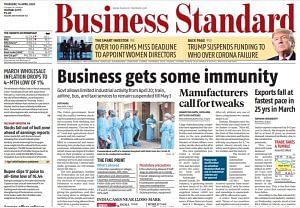 Though many papers have hailed the MHA’s lockdown guidelines, Business Standard notes that large manufacturers have approached the Centre for clarifications. For example, Maruti Suzuki is gathering details on how many of its vendors and suppliers are located in red zones “and if there is any alternate supply source if these firms are closed”, it reports.
Though many papers have hailed the MHA’s lockdown guidelines, Business Standard notes that large manufacturers have approached the Centre for clarifications. For example, Maruti Suzuki is gathering details on how many of its vendors and suppliers are located in red zones “and if there is any alternate supply source if these firms are closed”, it reports.
As if the economic conversation couldn’t get any hairier, the paper reports “contradictory moves” of RBI and SEBI. In ‘RBI, Sebi split over default recognition’, it notes: “RBI has announced a three-month moratorium on term loans given by banks, but is silent on liabilities of shadow banks”. Meanwhile, SEBI has “issued guidelines to rating firms, asking them to avoid assigning a default tag to companies that are unable to pay owing to the ongoing nationwide lockdown”, it adds.


